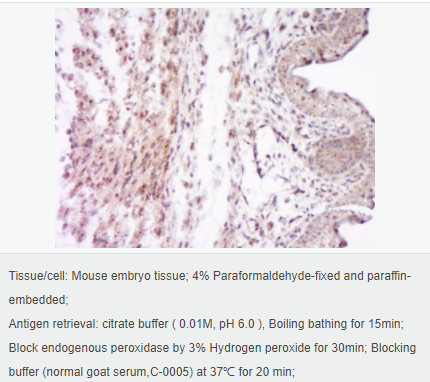

貨號
產(chǎn)品規(guī)格
售價
備注
BN40585R-100ul
100ul
¥2360.00
交叉反應(yīng):Human,Mouse,Rat(predicted:Rabbit) 推薦應(yīng)用:WB,IHC-P,IHC-F,ICC,IF,ELISA
BN40585R-200ul
200ul
¥3490.00
交叉反應(yīng):Human,Mouse,Rat(predicted:Rabbit) 推薦應(yīng)用:WB,IHC-P,IHC-F,ICC,IF,ELISA
產(chǎn)品描述
| 英文名稱 | SOCS7 |
| 中文名稱 | 信號轉(zhuǎn)導(dǎo)和轉(zhuǎn)錄激活因子7抗體 |
| 別 名 | NAP 4; NAP 4 Fragment; NAP4; Nck Ash and phospholipase C binding protein; Nck Ash and phospholipase C gamma binding protein; Nck associated protein 4; NCKAP4; SH2 domain containing SOCS box protein; SOCS 7; SOCS4; SOCS6; Suppressor of cytokine signaling 7;SOCS7_HUMAN. |
| 研究領(lǐng)域 | 細(xì)胞生物 免疫學(xué) 信號轉(zhuǎn)導(dǎo) 淋巴細(xì)胞 |
| 抗體來源 | Rabbit |
| 克隆類型 | Polyclonal |
| 交叉反應(yīng) | Human, Mouse, Rat, (predicted: Rabbit, ) |
| 產(chǎn)品應(yīng)用 | WB=1:500-2000 ELISA=1:5000-10000 IHC-P=1:100-500 IHC-F=1:100-500 ICC=1:100-500 IF=1:100-500 (石蠟切片需做抗原修復(fù)) not yet tested in other applications. optimal dilutions/concentrations should be determined by the end user. |
| 分 子 量 | 63kDa |
| 細(xì)胞定位 | 細(xì)胞漿 細(xì)胞膜 |
| 性 狀 | Liquid |
| 濃 度 | 1mg/ml |
| 免 疫 原 | KLH conjugated synthetic peptide derived from human SOCS7:171-270/581 |
| 亞 型 | IgG |
| 純化方法 | affinity purified by Protein A |
| 儲 存 液 | Preservative: 15mM Sodium Azide, Constituents: 1% BSA, 0.01M PBS, pH 7.4 |
| 保存條件 | Shipped at 4℃. Store at -20 °C for one year. Avoid repeated freeze/thaw cycles. |
| PubMed | PubMed |
| 產(chǎn)品介紹 | The eight members of the recently identified Suppressor of Cytokines Signaling (SOCS) family are SOCS1, SOCS2, SOCS3, SOCS4, SOCS5, SOCS6, SOCS7, and CIS. Structurally the SOCS proteins are composed of an N- terminal region of variable length and amino acid composition, a central SH2 domain, and a C-terminal motif called the SOCS box. The SOCS proteins appear to form part of a classical negative feedback loop that regulates cytokine signal transduction. Transcription of each of the SOCS genes occurs rapidly in vitro and in vivo in response to cytokines, and once produced, the various members of the SOCS family appear to inhibit signaling in different ways. SOCS1 and SOCS6 interact with the insulin receptor (IR) when expressed in human hepatoma cells (HepG2) or in rat hepatoma cells overexpressing human IR. SOCS1 and SOCS6 inhibit insulin-dependent activation of ERK1/2 and protein kinase B in vivo and IR- directed phosphorylation of IRS1 in vitro. These results suggest that SOCS proteins may be inhibitors of IR signalling and could mediate cytokine-induced insulin resistance and contribute to the pathogenesis of type II diabetes. SOCS6 and SOCS7 are expressed ubiquitously in murine tissues and SOCS6 knockout mice are growth retarded. Function: Regulates signaling cascades probably through protein ubiquitination and/or sequestration. Functions in insulin signaling and glucose homeostasis through IRS1 ubiquitination and subsequent proteasomal degradation. Inhibits also prolactin, growth hormone and leptin signaling by preventing STAT3 and STAT5 activation, sequestering them in the cytoplasm and reducing their binding to DNA. May be a substrate recognition component of a SCF-like E3 ubiquitin-protein ligase complex which mediates the ubiquitination and subsequent proteasomal degradation of target proteins. Subunit: Interacts with phosphorylated IRS4 and PIK3R1 (By similarity). Interacts, via the third proline-rich region, with the second SH3 domain of the adapter protein NCK1. Also interacts with GRB2, INSR, IRS1, PLCG1, SORBS3/vinexin, and phosphorylated STAT3 and STAT5. Interacts with SEPT6. Subcellular Location: Cytoplasm. Cell membrane; Peripheral membrane protein; Cytoplasmic side. Nucleus. Note=Mostly cytoplasmic, but shuttles between the cytoplasm and the nucleus. Rapidly relocalizes to the nucleus after UV irradiation. Cytoplasmic location depends upon SEPT7 presence. Tissue Specificity: Expressed in brain and leukocytes. Also in fetal lung fibroblasts and fetal brain. Similarity: Contains 1 SH2 domain. Contains 1 SOCS box domain. SWISS: O14512 Gene ID: 30837 Database links: Entrez Gene: 30837 Human Omim: 608788 Human SwissProt: O14512 Human SwissProt: Q8WXH5 Human Important Note: This product as supplied is intended for research use only, not for use in human, therapeutic or diagnostic applications. |

